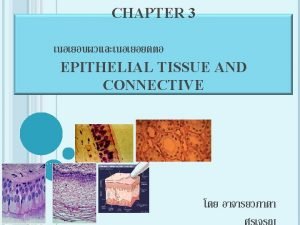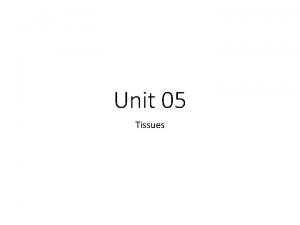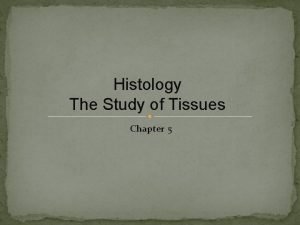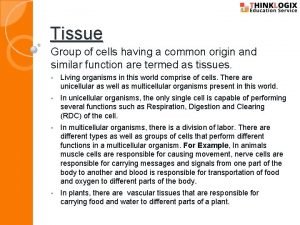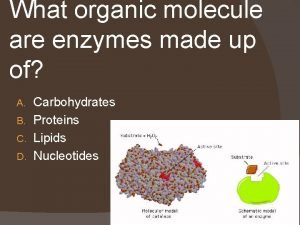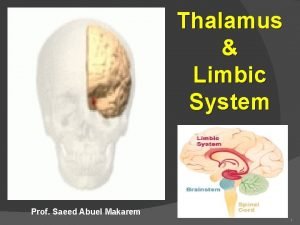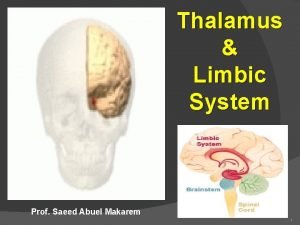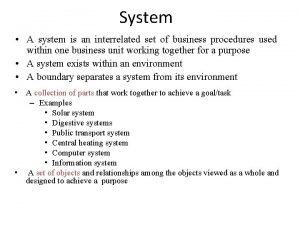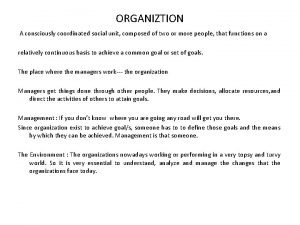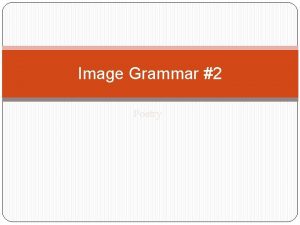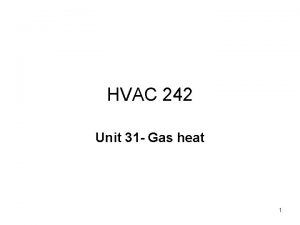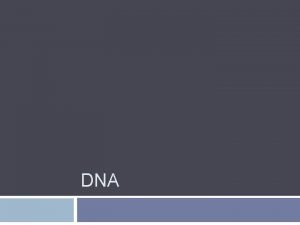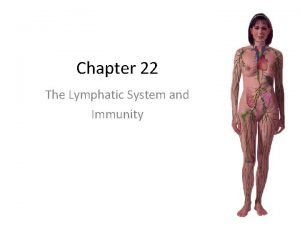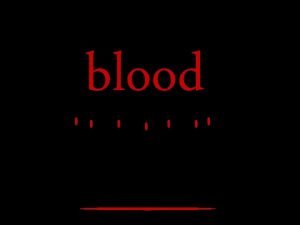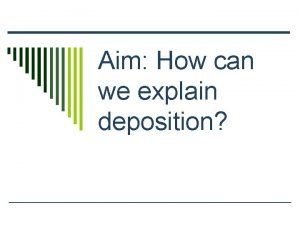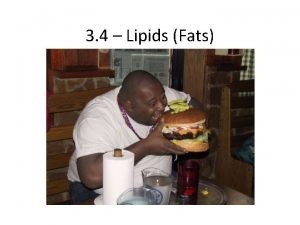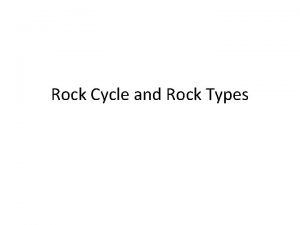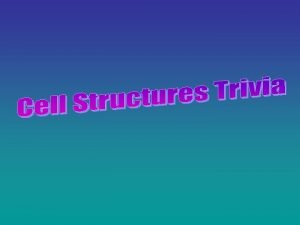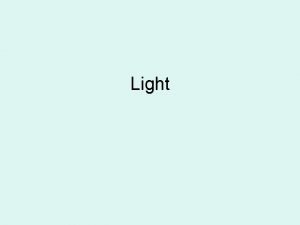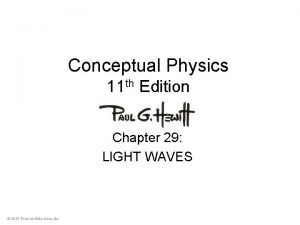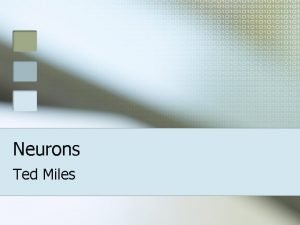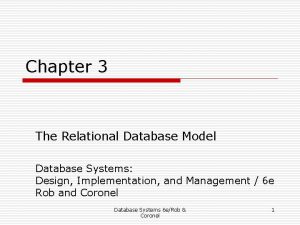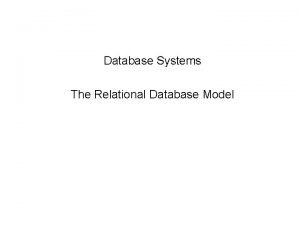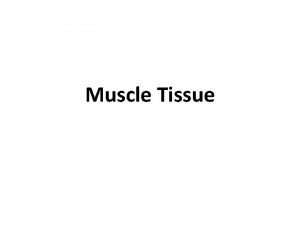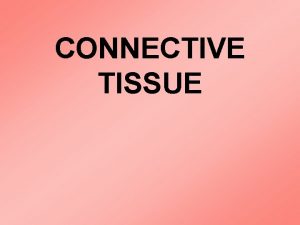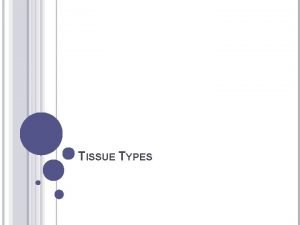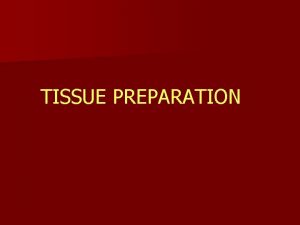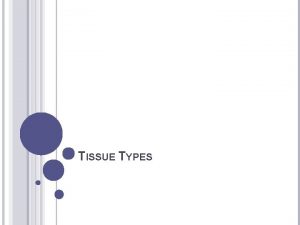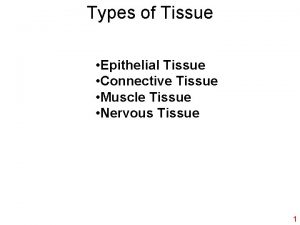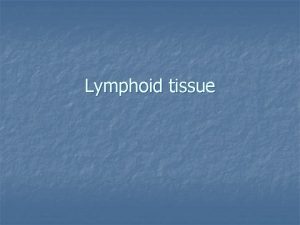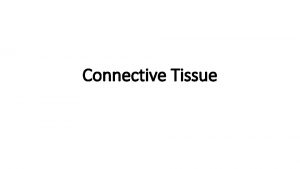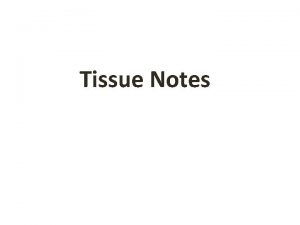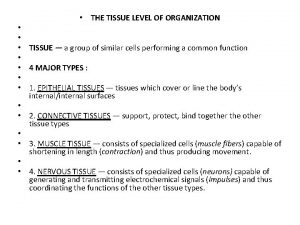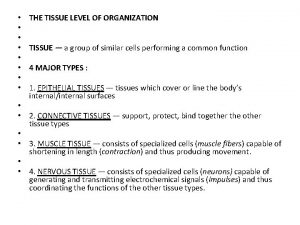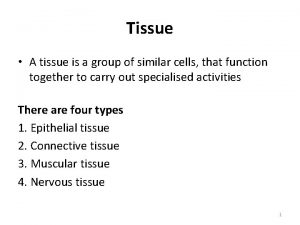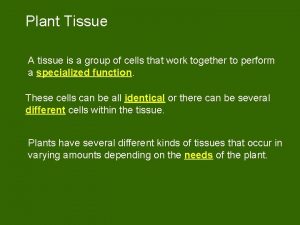A TISSUE IS COMPOSED OF A GROUP OF














































- Slides: 46





A TISSUE IS COMPOSED OF A GROUP OF CELLS WITH SIMILAR STRUCTURE THAT PERFORM RELATED FUNCTIONS AND ARE SURROUNDED BY EXTRACELLULAR MATERIAL (NON-LIVING). THE FOUR DIFFERENT TISSUE TYPES CAN BE ASSOCIATED WITH A GENERAL FUNCTION: EPITHELIAL FOR COVERING, CONNECTIVE FOR SUPPORT, MUSCLE FOR MOVEMENT, AND NERVOUS FOR CONTROL.








1. Simple epithelia- a single layer of epithelia is called simple epithelia, it is design to allow molecules to cross the membrane quickly, such as in the capillaries and lungs. i. Simple squamous epithelia- a flat layer of cells. Endothelium produces a slick slippery surface. Mesothelium serves as a middle covering as part of serosa found in body cavities.

Simple cuboidal epithelia- a layer of cube like cells, their height and width are just about equal. It form gland ducts and tubules.

• Simple columnar epithelium- a layer of tall cells that line the digestive tract. It functions in absorption, secretion, and ion movement, some as cilia in their apical side.

Pseudostratified Columnar Epithelium- a single layer with cells of different heights which makes it appearing as if there are different layers. Short cells are undifferentiated and give rise to tall cells. Tall cells function in secretion and absorption.

2. Stratified epithelia- two or more layers of cells, cells rise from basal side, main function is protection. i. Stratified squamous epithelium- many layers of cuboidal or columnar cells with squamous cells at the surface. It is the best for protection and lines areas that are often-abraded. They make up the skin and MAY OR MAY NOT have keratin.

ii. Stratified cuboidal and columnar epithelium- rare and forms only large ducts of glands.


iii Transitional epithelium- lines hollow urinary organs and has the ability to stretch from six to three cells thick.

Glands- groups of epithelial cells that make and secrete a substance. Glands may be unicellular or multicellulaer. 1. Exocrine Glands- substances like mucus, sweat, and saliva are secreted onto body surfaces or cavities. Multicellular exocrine glands have ducts and can be classified by the number and arrangement of the ducts (see page 79). 2. Endocrine Glands- have no ducts, secrete hormones into the blood stream.



องคประกอบเนอเยอเ กยวพน 1. เซลล (cell( - Fibroblast - Macrophage - Mast cell - Plasma cell - White blood cell - Adipocyte (Adipose cell or Fat cell)




Other Loose Connective Tissues- these are connective tissues that resemble areolar connective tissue. 1. Adipose Tissue- 90% fat cells (white adipose), highly vascularized, found below skin and mesenteries, cushions kidneys and eyes. In babies brown adipose keeps them warm.

2. Reticular connective- only has reticular fibers in the matrix that forms a supportive mesh. Found in bone marrow, spleen, and lymph nodes

Dense Connective Tissue- contains a high percentage of collagen. 1. Irregular dense connective tissue has thick collagen fibers running in different planes, it is found in the dermis and capsules around organs.

2. Regular dense connective tissue have fibers that run parallel to the pull direction, poorly vascularized, makes up tendons and ligaments, high amount of elastic fibers.

Other Connective Tissues: Cartilage, Bone, and Blood- connective tissue types that resist compression. 1. Cartilage- firm but flexible, high tissue fluid, no blood or nerves, has chondrocytes and chondroblasts. There are three types of cartilage: Hyaline, Elastic, and Fribrocartilage.



2. Bone Tissue- highly supportive and protective, matrix has inorganic salts, high collagen fiber content, has osteocytes

3. Blood- most unusual connective tissue, develops from mesenchyme cells and has plasma (nonliving matrix). It transport nutrients and cell

Muscle Tissue- involved in body movement because cells are capable of contraction, contains myofilaments (muscle filaments), there are three types. a. Skeletal muscle- attatches to bones, striated, multiple nucleic cells

Muscle Tissue- involved in body movement because cells are capable of contraction, contains myofilaments (muscle filaments), there are three types. a. Skeletal muscle- attatches to bones, striated, multiple nucleic cells

b. Cardiac muscle-makes the heart, striated, single nucleated cells, involuntary, pumps blood.

b. Cardiac musclemakes the heart, striated, single nucleated cells, involuntary, pumps blood.

• c. Smooth muscle- lines organs, no striations, spindle shaped cells, involuntary, moves substances inside the body.

c. Smooth musclelines organs, no striations, spindle shaped cells, involuntary, moves substances inside the body.

IV. Nervous Tissue- makes up the brain, spinal cord, and nerves that innervate the body. Some nervous system cells have the ability to create electrical impulses and stimulate other tissue. a. Neurons- nerve cells that extend long distances and can send an impulse to activate a cell. These control body function. b. Glial- nerve cells that form supportive structures, insulate, and nourish neurons. These cells come in direct contact with neurons but do not control body function



 Tissue is composed of a group of -
Tissue is composed of a group of - Characteristics of simple columnar epithelium
Characteristics of simple columnar epithelium Reticuloendothelial tissue is composed of cells that are
Reticuloendothelial tissue is composed of cells that are Jaringan epitel dapat ditemukan di
Jaringan epitel dapat ditemukan di Tissue is a group of cells having
Tissue is a group of cells having Enzymes are composed of what organic molecule
Enzymes are composed of what organic molecule Who has composed the poem the solitary reaper
Who has composed the poem the solitary reaper Erm relationships
Erm relationships Internal medullary lamina
Internal medullary lamina Limbic lobe
Limbic lobe Interrelated system
Interrelated system Skin composed of
Skin composed of Wordsworth poem westminster bridge
Wordsworth poem westminster bridge An organization is a consciously coordinated social unit
An organization is a consciously coordinated social unit Who is the poet of the poem money madness
Who is the poet of the poem money madness Lines composed a few miles above summary
Lines composed a few miles above summary A poem of free verse that the japanese like
A poem of free verse that the japanese like Hvac unit 31 test answers
Hvac unit 31 test answers What is nucleic acid composed of
What is nucleic acid composed of Lymph is composed of
Lymph is composed of Blood consists of
Blood consists of What is blood composed of
What is blood composed of Jj johnson
Jj johnson A low hill is composed of unsorted sediments
A low hill is composed of unsorted sediments Triglycerides are composed of
Triglycerides are composed of Wood is composed of
Wood is composed of It is a self portrait composed of many pieces
It is a self portrait composed of many pieces Is a self-portrait composed of many pieces
Is a self-portrait composed of many pieces Composed mainly of minerals with blocky crystal shapes
Composed mainly of minerals with blocky crystal shapes The nucleolus is composed chiefly of:
The nucleolus is composed chiefly of: White light is composed of
White light is composed of Humanities art appreciation
Humanities art appreciation Asm chart
Asm chart Huygens principle features wavefronts that are composed of
Huygens principle features wavefronts that are composed of Earth has not anything to show more fair figure of speech
Earth has not anything to show more fair figure of speech Wispy clouds that are found at middle elevations
Wispy clouds that are found at middle elevations An unknown gas composed of homonuclear diatomic molecules
An unknown gas composed of homonuclear diatomic molecules It is a self-portrait composed of many pieces.
It is a self-portrait composed of many pieces. Is a movable plate that covers the shuttle and bobbin case
Is a movable plate that covers the shuttle and bobbin case What are neurons composed of
What are neurons composed of Traditionally, composed of a collection of file folders.
Traditionally, composed of a collection of file folders. Two-dimensional structure composed of rows and columns
Two-dimensional structure composed of rows and columns Two-dimensional structure composed of rows and columns
Two-dimensional structure composed of rows and columns The ffa emblem is composed of
The ffa emblem is composed of Essay is composed of
Essay is composed of Olympic creed and oath was composed by
Olympic creed and oath was composed by Universe is composed of
Universe is composed of
